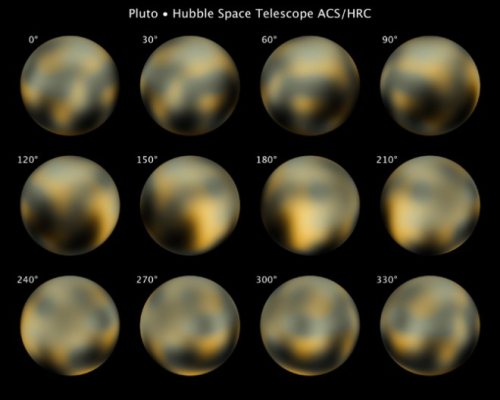PLUTO UNMASKED
These pics of the dwarf planet Pluto are not only really, really kewl, but how they were created is pretty kewl too.
After more than four years of processing on 20 hand-built computers, the best views ever captured of Pluto are now available.
Working from 384 images taken by the Hubble Space Telescope in which the image of Pluto itself was just a few pixels across, astronomer Marc Buie and his team at the Southwest Research Institute stitched together the maps of Pluto you see here.
“It also shows you what I consider to be my best guess for what the true color of Pluto would be if you were puttering around near it in a spacecraft,” Buie said in a NASA teleconference.
Pluto has mostly been in the news in recent years for its demotion from planet to dwarf planet and subsequent attempts to get it lumped back in with the bigger, round objects of the solar system.
But astronomer Mike Brown of the California Institute of Technology, aka @PlutoKiller on Twitter, said the question of the classification of the celestial body doesn’t merit the attention it’s gotten.
“That’s really not an interesting question to ask,” said Brown, who was not involved with the research. “It’s a great place to study.”
Specifically, what’s fascinating to Brown and Buie is the tremendous amount of change that has been observed on Pluto, particularly between images obtained in 1994 and 2003. Based on the new processing of the photos, there has been more change on Pluto than Earth or Mars.
“You’re looking at the surface in the solar system where there are the biggest changes we’ve ever seen,” Brown said.
First, the series of pictures:

They’ve already discovered one dwarf planet that is bigger than Pluto so it would seem the re-classification of the former 9th planet was a good idea.
But given the fact that even Hubble can only resolve the tiny body to what amounts to a faint smudge, these pictures are awesome. Also, given what scientist Mark Buie had to work with as far as funding to get this project done, I think some consideration for a Nobel might be in order:
The computing power necessary to turn the pixels of Pluto into the global map seen above is considerable. Buie hand-wrote all the code in a combination of IDL, a scientific programming language, and C. But when he finished and began to crunch the data, it appeared that it would take decades for the calculations to complete.
So, he took the funding he had and scraped together 20 computers to do the work in parallel.
“I bought these little shuttle boxes and a processor and memory. I got [the price] down to $450 per computer and I had enough to buy 20 computers and have them all grind,” he said. “That’s about the cheapest supercomputer you can manage.”
His team’s handiwork includes this little video of Pluto rotating:
It’s been a while since I wrote about the New Horizon’s spacecraft that recently passed the point where it is now closer to Pluto than it is to earth. It is the fastest moving object ever created by man, speeding toward a swing around Jupiter to get a gravity assist at more than 31,000 MPH. The previous record was held by Voyager I which is now approaching the outer reaches of the heliosphere.
I wrote of the mission back in 2005:
One of the most amazing things to me, a 51 year old amateur space nut, is that the missions NASA has launched to the planets over the last 40 years have been conducted largely under the radar of press coverage and interest by the American people. This state of affairs will probably be looked on 500 years from now by historians with some measure of astonishment. They will marvel at the fact that mankind’s initial attempts to explore their solar system neighborhood would have been met with a collective yawn by a media that routinely reports every pimple that breaks out on Brittany Spear’s face but can’t find the time or effort to describe the wondrous, almost magical efforts to answer questions that have been asked by humanity since our ancestors were loping effortlessly across the African savannah.
Who are we? Why are we here? Are we alone?
In a very real sense, NASA’s New Horizon’s mission to Pluto and the Kuiper Belt beyond will close the first chapter in our quest to solve some of the most fundamental mysteries of the universe. And the fact that this effort has been given such short shrift by our celebrity-obsessed, trivia reporting media reveals much about our manic efforts to remain ignorant about matters so sublime in their implications for adding to the encyclopedia of human understanding that one could actually question the collective sanity of the human race if not for the fact that there are plenty of examples already.
Pluto is such a bizarre object, some of its characteristics are science fiction-like. Scientists are guessing that it’s so cold on Pluto, that the atmosphere actually freezes on its outward leg away from the sun so that it descends to the planet’s surface. This may spell trouble for New Horizons because if that is the case, it will almost certainly obscure any surface features we might be able to photograph.
But it is the last leg of the mission that promises to expand our understanding of the origins of the solar system tremendously. After the Pluto flyby, New Horizons is scheduled to continue onward to the mysterious Kuiper Belt. Objects in the Belt are thought to be left over from the very early days of the solar system’s existence. Studying them may make us revise our theories on how the planets formed.
The Pluto flyby is scheduled for July, 2015.